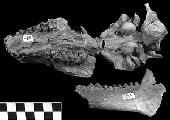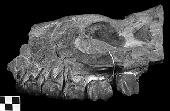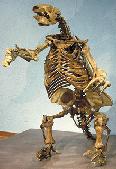|
 See More Images See More Images

Eucrotaphus trigonocephalus
© 1996 public domain

Diceratherium annectens
© 1996 public domain

Nothrotheriops
© 2003 Nevada State Museum, Las Vegas
|
What are Placentals? Placental mammals are the most diverse group of mammals. Some can fly (bats, colugos, and flying squirrels), and others swim (whales, dolphins, and manatees), but the majority live on land, like elephants, sloths, horses, dogs, sheep, rodents, primates, and many more. Despite this diversity, many groups of placentals have gone extinct, such as the Creodonta, Condylarthra, Desmostylia, and Embrythopoda. In placental mammals, the embryo develops internally in an organ called the placenta that provides gas exchange, nourishment, and waste removal for the embryo. First known fossil occurrence: Cretaceous. Last known fossil occurrence: Quaternary. This group has living relatives. |
Fossils through time:
Choose a time period to see what life was like:
|
|